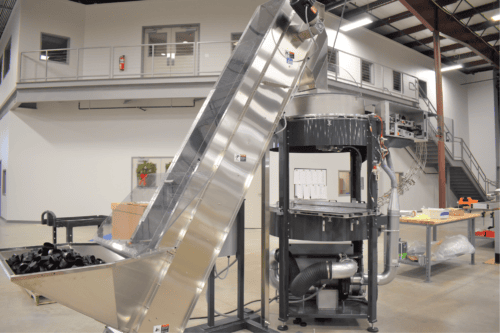Feeder automation is one of the best ways to improve assembly-line efficiency. But what is feeder automation, exactly? Broadly, the term refers to replacing costly manual labor with faster, more accurate machines that can select, sort, orient, and transport components through the assembly line. Most companies that move high volumes of small parts can benefit from feeder automation.
Types of Feeder Systems
A feeder system is a part of an automated assembly line that moves components from one station to the next. Typically, these devices move components from a storage hopper to a processing station, or from one processing station to the next.
Different applications call for different automated parts feeding devices:
- Vibratory Bowl Feeders: Vibratory bowl feeders use an electromagnetic spring mechanism to generate vibrations, which drives parts through guides to sort and orient parts correctly. Adjusting the intensity of these vibrations allows the feeder to accommodate different part sizes and volumes.
- Centrifugal Bowl Feeders: Centrifugal bowl feeders are designed to drive components to the outer edge of the bowl, seating into pockets that accept only one orientation. Because they do not rely on vibrations, these feeders can handle small or fragile components that would not withstand strong vibrations.
- Pneumatic Bowl Feeders: Pneumatic bowl feeders perform the same role as vibratory bowl feeders. However, rather than an electromagnetic coil and springs, they use a pneumatic drive unit and piston engine to generate vibrations. This mechanism presents an alternative means of orienting, sorting, and transporting parts in sensitive environments like laboratories.
- Linear Feeders: Linear feeders differ from bowl feeders in that they convey components in-line, often after parts have been positioned by other units. These feeders may use a variety of mechanisms ranging from vibrating tracks to conveyor belts, but they share the function of moving parts from one workstation to the next.
- Vibrating Hoppers: Vibrating hoppers operate similarly to vibrating linear feeders, but their function in the assembly line is different. Rather than moving parts out of a bowl feeder, as linear feeders often do, vibrating hoppers control the flow of components into those feeders. This prevents overfilling and optimizes the overall process.
- Elevators: Elevators are similarly used to control the flow of components into feeders, typically with an inclined, cleated belt. However, they are specifically used when components must be moved up or down to reach the next feeder. Depending on the assembly line’s configuration, elevators distribute components from a feeder to one or more downstream feeders.
- Waterfall Feeders: Waterfall feeders are typically used to sort and orient caps before feeding them into a capping system. These feeders are ideal for optimizing packaging operations across a range of applications.
- High-Speed Vacuum Feeders: High-speed vacuum feeders employs the use of a vacuum to sort materials into two streams based on orientation. Using an upright and an inverted track, all parts are sorted in the appropriate orientation to suit the application This system significantly increases efficiency by improving throughput and saving energy.
The Benefits and Applications of Feeder Systems for Automated Assembly
Using the right feeder system for your assembly line promises many benefits, chief among which is heightened efficiency. With an automated feeder system, you can achieve faster processes and higher output rates, all while reducing the potential for human error. These benefits combine to make your process as efficient as possible, maximizing profit and resulting in quick ROI.
Feeder systems are also immensely flexible. Not only are there different types of feeders for different applications, but each system is highly configurable to suit different input components and throughput rates. They can also be reconfigured when needs change, keeping assembly lines agile.
Feeder systems are ideal for the following repetitive applications, including:
- Sorting and diverting components in bulk
- Loading high volumes onto machines or conveyors
- Moving components and products through large facilities
- Sorting caps and packaging bottles
- Assembling small or intricate products
- Keeping long components detangled
The team at CapTech can help you determine which automated feeders are most appropriate for your application.
Efficient Assembly Line Automation With CapTech
CapTech Automation has provided custom automation and process control solutions for decades. To learn how our turnkey solutions can make your facility more efficient, contact us or request a quote today.

